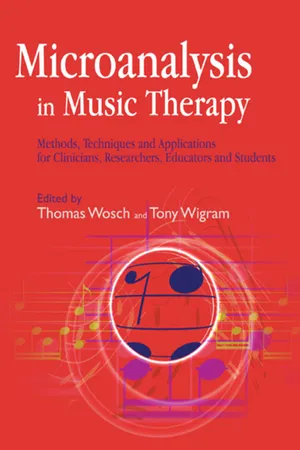![]()
Chapter 1
Microanalysis in Music Therapy: Introduction and Theoretical Basis
Thomas Wosch and Tony Wigram
Introduction
The development of music therapy as a profession placed within the areas of health, education and the social system, as well as in some more specialized areas, such as care of the terminally ill and prisons, is documented in the literature by many theoretical books, case studies, and research reports (American Music Therapy Association [AMTA] 2000; Bruscia 1987, 1991; Bruscia and Grocke 2002; Decker-Voigt 2001; Schwabe and Stein 2000; Wigram and De Backer 1999a, 1999b; Wigram, Nygaard Pedersen and Bonde 2002). The method and technique employed in the practice of music therapy has received less attention, as the majority of clinical applications are taught to music therapists through varied lectures and experiences in practicums, as well as through supervision. Beside some early texts on method (Nordoff and Robbins 1977; Schwabe 1974, 1978; Unkefer 1990) more recently texts have begun to emerge that give detailed explanations of the application of music therapy techniques, allowing a greater degree of consistency in the terminology used, and in treatment interventions (Baker and Wigram 2005; Grocke and Wigram 2006; Wigram 2004).
Methods of analyzing and documenting music therapy interventions have also received less than necessary attention, for two probable reasons. First, the main focus has over the period of development since 1945 been mainly on empirical clinical experience. Second, there has been almost a reluctance to address the more difficult process of analyzing and documenting clinical work systematically, and especially through standardized tools to which everyone would subscribe and in the application of which everyone would be trained. Exceptions exist, for example in the training given by Nordoff-Robbins courses since their inception in the method of analyzing and reporting the tapes of sessions, and also in the systematic record keeping of behavioral changes in the more behaviorally oriented approaches in the US, which often use nonmusical tools for an analysis or research studies (AMTA 2000; Gregory 2000).
However, especially in the last five years, a large number of research studies have involved the development of detailed analysis tools, or the use of existing ones – musical, textual, video, and even physiological. With the exception of physiological tools, this book is going to try and meet the challenge of converting these into “user-friendly” clinical tools. The focus of the book is restricted to tools that involve microanalysis – the detailed analysis of a small but relevant amount of data drawn from a single experience with a client, or a single session. In the majority of chapters the microanalyses are of active music making, where the therapist and client(s) are engaged in shared musical experiences. The analysis of musical activity, interpersonal behavior, clients’ expressions, communication, emotions, and many other parameters has long since been the foundation of the arguments regarding the benefits and validity of music as a therapeutic intervention. However, research studies and case study reports frequently offer only limited explanation of how musical or verbal material has been systematically analyzed. The few studies that do usually describe a complex and lengthy process of analysis, sometimes with multiple dimensions, that is inaccessible for clinical practitioners as a relevant tool. This book seeks to document a selection of analysis methods that fall within the category of microanalysis, most of them grounded in research studies, all of which can be adapted and applied for use in training music therapists and for everyday clinical practice. In addition to musical activity, verbal interaction and other nonmusical behavior in music therapy are also analyzed.
The concept of microanalysis
Even though microanalysis can play an important role in day-to-day music therapy practice when the therapist has to make spontaneous decisions during a session, it is only sparsely found in music therapy literature (Holck 2002; Plahl 2000; Wosch 2002, 2004). The term “microanalysis” has a much longer history and is used systematically in related disciplines such as psychotherapy (Schindler 1996; Stuhr 1997), pedagogic disciplines like special education (Greving 2000), and in the academic field of music psychology (Scherer and Zentner 2001; Trevarthen and Malloch 2000). The specific “objects” in focus for a microanalysis should be understood and defined as minimal changes in relationships or interactions between people or minimal changes in the music and in dynamic forces. For clinical practice it is very important that one has the ability to consciously perceive and critically analyze therapy process, and with those skills to react appropriately to very small changes in social, musical, and emotional behavior and experiences within a therapeutic context. This book offers a wide range of instruments, analysis tools, and aids for systematically supporting these perceptions through a multitude of microanalysis methods in music therapy – as if it were put under a microscope – for different problems in clinical practice, different client populations, and different approaches of music therapy. The emphasis is on methods and techniques, and the editors have formulated a model for each chapter to ensure that clearly defined procedures for applying the methods of microanalysis are articulated. The structure and content of each chapter are explained below.
Benefits for clinicians, students, and researchers
Three categories of reader will profit from this book. The first group is clinicians. For them the different kinds of microanalysis provide possibilities for answering specific questions from thei...
